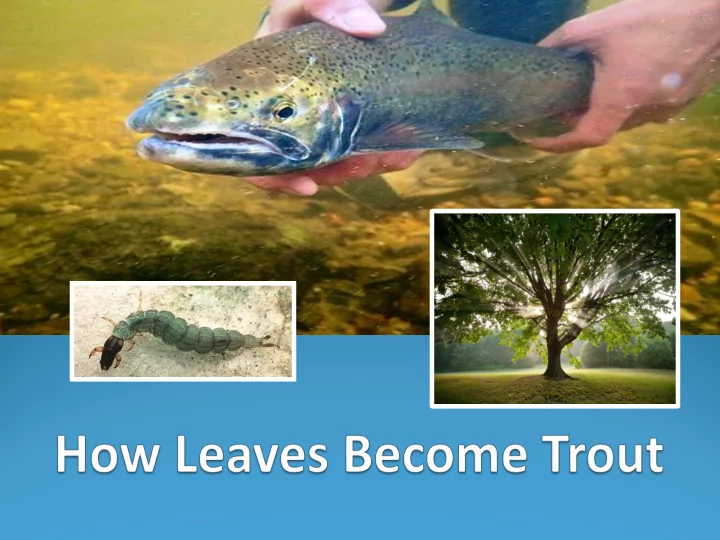

Condensation Precipitation Snowmelt Springs Streams and Lakes rivers Infiltration Evaporation into the ground Aquifers Ocean Storage Groundwater flow to oceans
A watershed is an area of land from which all runoff drains, or ' sheds ' to the same river, lake, or other body of water.
Do you live in a watershed? YES! Everyone lives in a watershed.
Cold Water Clean Water Food Places to Hide Gravel
Trout Eat Stream Insects
Stream Insects Eat Leaves
Did you Know?
Macroinvertebrates can tell us the quality of the water. Every species of animal has a range of physical and chemical conditions in which it can survive. Some invertebrates are sensitive and will not survive in polluted waters, others will tolerate a little to a lot of pollution.
Macroinvertebrates can tell us the quality of the water. In the cleanest ponds, lakes, and rivers, you’ll find the greatest diversity of aquatic invertebrates. In polluted waters, only a few species can survive.
Sensitive Macroinvertebrates Some can survive ONLY in clean water
Somewhat-Sensitive Macroinvertebrates Some can survive in medium clean water
Tolerant Macroinvertebrates Some can survive in both clean and polluted water
Creepy Critter Game
Leaf Pack Network
The Leaf Pack Network Network of citizens, teachers, and students investigating their local stream ecosystems. Create an artificial leaf pack and place it in a stream. Collect and examine the packs in the classroom. Discover aquatic insects that indicate stream health, showing the connection between trees and streams. Share data through the network.
http://www.leafpacknetwork.org
What will you be doing? Plan our Experiment – TODAY Prepare Leaf Packs and put them in Creek- TOMORROW Collect Leaf Packs from Creek – NEXT MONTH Identify Insects – NEXT MONTH Interpret Data – NEXT MONTH What is the Water Quality of Our Site? – NEXT MONTH
Scientific Method The scientific method is a way to ask and answer scientific questions by making observations and doing experiments. - Ask a Question - Do Background Research - Construct a Hypothesis - Test Your Hypothesis by Doing an Experiment - Analyze Your Data and Draw a Conclusion - Communicate Your Results
Question 1 Group One: A local stream has a lot of stormwater pipes entering it and we want to know if it is affecting water quality. --amphipod How would this be tested using the leaf packs? Hypothesis?
Question 2 Group Two: A landowner cut down trees along a stream and we want to know if it is affecting water quality. --amphipod How would this be tested using the leaf packs? Hypothesis?
Question 3 Group Three: A company is constructing a building next to a stream causing soil to run into it. We are curious if it is affecting water quality. --amphipod How would this be tested using the leaf packs? Hypothesis?
Preparing Leaf Packs Collect leaves that are common around Creek and place them in the mesh bag. Use the scale to weigh 30 grams of dry leaves in each leaf pack. --amphipod Complete the tag for each mesh bag and place tag in leaf pack bag. Tie bag closed. Loop a long length of string through leaf pack so it can be tied to a rock (or log or roots).
Placing Leaf Packs in Stream Tie leaf pack directly in to stream to rock (log or root). Position leaf pack facing upstream so that as much of the surface area of the bag is facing the current --amphipod as possible. Make sure all leaf pack are submerged and securely tied. Have students record where they put them Keep leaf packs in stream 3-4 weeks.
Collect Leaf Packs
Collecting Insects
Identifying Insects
Interpret Data Classroom Presentations Uploading Data on Network Interpret Data
Additional Tools Leaf Pack Network Resource Manual Leaf Pack Data Sheets Habitat Assessment Insect ID sheet --amphipod Learning Activities Tree ID Leaf Pack Crossword
Field Work Today Prepare One Leaf Pack Per Group Tie Leaf Packs in Stream --amphipod Habitat Assessment
Questions?
Recommend
More recommend